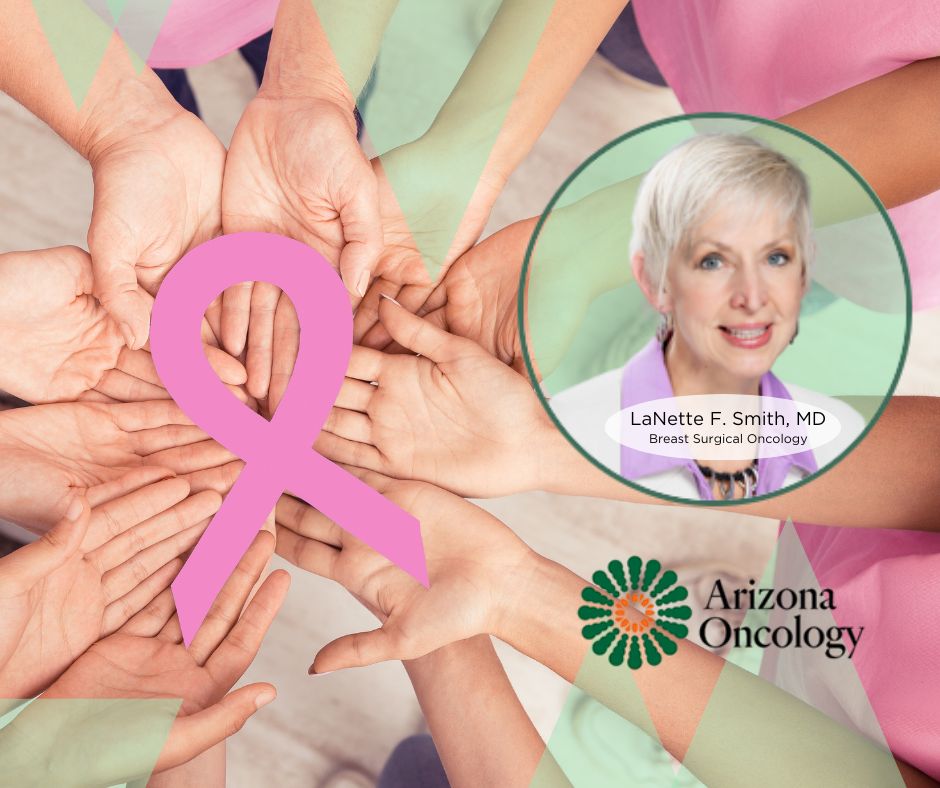Q&A with Breast Surgical Oncologist LaNette F. Smith, MD
Most women, when faced with a breast cancer diagnosis, want to know what their surgical options are. While the majority have a general understanding of terminology such as “lumpectomy,” “mastectomy,” and “double mastectomy,” much nuance exists within those larger categories, and new techniques, innovations, and options continue to develop.
Dr. LaNette Smith, breast surgical oncologist at Arizona Oncology, shares updated information about breast cancer surgery and the choices available to patients, as well as information she wants every breast cancer patient to know.
What types of breast surgery are available to women with breast cancer?
Dr. Smith points out that a multitude of variations exist under the umbrella of lumpectomy and mastectomy.
For patients undergoing a lumpectomy, she points to oncoplastic procedures as an option that may provide the best cosmetic outcome. Oncoplastic techniques combine cancer removal with plastic surgery to reshape the breast immediately after the tumor is removed. These techniques can include:
- Tissue rearrangement
- Reduction/lift (especially if the breasts are large)
- Matching procedure on the opposite breast for symmetry
For patients undergoing mastectomy, Dr. Smith points to several variations of reconstruction, most of which can be done at the time of the mastectomy by a combination team of surgical oncologist and plastic surgeon.
- Aesthetic flat closure. Also referred to as post-mastectomy chest wall reconstruction, this technique can be done at the time of the mastectomy or a few months later. The surgeon removes extra skin, pockets of fat, and excess tissue while smoothing out what remains to create a flat chest wall contour. This technique works well for patients with a higher BMI, larger breasts, a tumor located close to the chest wall, and/or when radiation therapy has affected skin and tissue quality in the surrounding area.
- Implant-based reconstruction. “Locally in Prescott, we have resources to perform tissue expander and direct implant reconstructions along with mastectomy,” says Dr. Smith. This allows implants to be placed directly following the mastectomy, during the same surgery. Newer techniques involve placing the implant on top of the chest muscle instead of under it. “This involves much less pain and is an easier recovery,” Dr. Smith says.
- Autologous tissue transfer reconstruction. An alternative to implants, autologous tissue transfer involves using tissue from another area of the body to rebuild the breast. Tiny blood vessels are connected to establish blood flow to the transplanted tissue.
“Most patients are very happy with reconstruction,” Dr. Smith says. She adds that variations of techniques for both nipple preservation and sometimes nerve sensation can be accomplished.
Are there any new developments that women should know about?
According to Dr. Smith, the new developments in breast cancer surgery involve reducing the number of surgeries, in certain circumstances. For example, sentinel node biopsy, a procedure performed to detect cancer in the lymph nodes, can disrupt the lymphatic system, producing lymphedema—a build-up of fluid in the arm, chest, or armpit area.
“We have studies now such as the SOUND trial which allow us to perhaps omit sentinel lymph node biopsy for women who have nodes that seem negative by imaging. This lowers the risk of lymphedema for the patient,” Dr. Smith explains. This is often recommended for patients over the age of 70 with estrogen-positive breast cancers and clinically negative lymph nodes.
“Further, recent publication of the COMET trial supports that the potential for active monitoring for certain patients with hormone receptor-positive grade 1 or grade 2 DCIS is not inferior to surgery. We also have significant data that supports the potential for omission of radiation for selected women with favorable breast cancers. These patients are typically over 70 with smaller estrogen receptor-positive tumors that are lymph node-negative,” Dr. Smith says.
“The use of immune therapy for patients with triple-negative breast cancers can be quite effective for converting women who start off with positive nodes to node-negative prior to surgery,” she goes on to add. “This allows for removal of fewer lymph nodes and a lower risk of lymphedema for the patient.”
What should women consider in order to make the best decision?
Dr. Smith urges breast cancer patients to make their treatment decisions in close consultation with their team of physicians. “I would caution patients about advice from lay people who perhaps had an entirely different type of breast cancer or were treated at a time when guidelines were different. While these people are well-meaning, they can sometimes cause confusion.”
She recommends bringing a reliable partner or friend to all appointments who can talk through decisions with you. “We always welcome patients to have second opinions from other board-certified medical professionals trained in the treatment of cancer, if desired,” she adds.
What are some things that patients found surprising after surgery?
“Many patients are surprised by how quickly they recover from the surgery,” says Dr. Smith. She states that a large number of her lumpectomy patients only take Tylenol for post-operative pain. “They are also often surprised about how little time the actual surgery takes,” she adds.
What is something you tell all of your patients who are undergoing surgery for breast cancer?
Dr. Smith points out that surgery is just one event in the journey of breast cancer. “Rarely is surgery the only modality we use to treat breast cancer,” she explains. “For the surgery itself, we always want the patient to know we will do our very best to take excellent care of her.”
It’s not just the surgeon who is committed to an optimal outcome, she adds. A dedicated team, from nurses to imaging specialists to office staff, all work together to ensure treatment goes as smoothly as possible. “These individuals are a key part of the team,” she says.
What is the best thing women can do for their recovery?
“Take it a day at a time,” Dr. Smith advises. And, in the long run, she recommends eating healthy, exercising, and staying up-to-date on follow-up exams and appointments.
To learn more about Dr. Smith and the team of breast cancer specialists at Arizona Oncology, visit arizonaoncology.com.



